Comprehensive Analysis: Material Properties and Degradation Methods
VerifiedAdded on 2022/09/12
|16
|5090
|10
Report
AI Summary
This report provides a comprehensive overview of material properties, including elastic moduli, hardness, ductility, toughness, electrical conductivity, magnetic permeability, and permittivity. It explores various degradation methods such as creep, fatigue, corrosion, ultraviolet degradation, and thermal shock, detailing their causes and prevention strategies. The report also outlines scientific experiments and research methodologies, including both destructive and non-destructive testing methods, with an emphasis on quantitative and qualitative research approaches. The content covers the importance of understanding material characteristics for engineers, and the impact of environmental factors on material performance, making it a valuable resource for students of materials science and engineering.
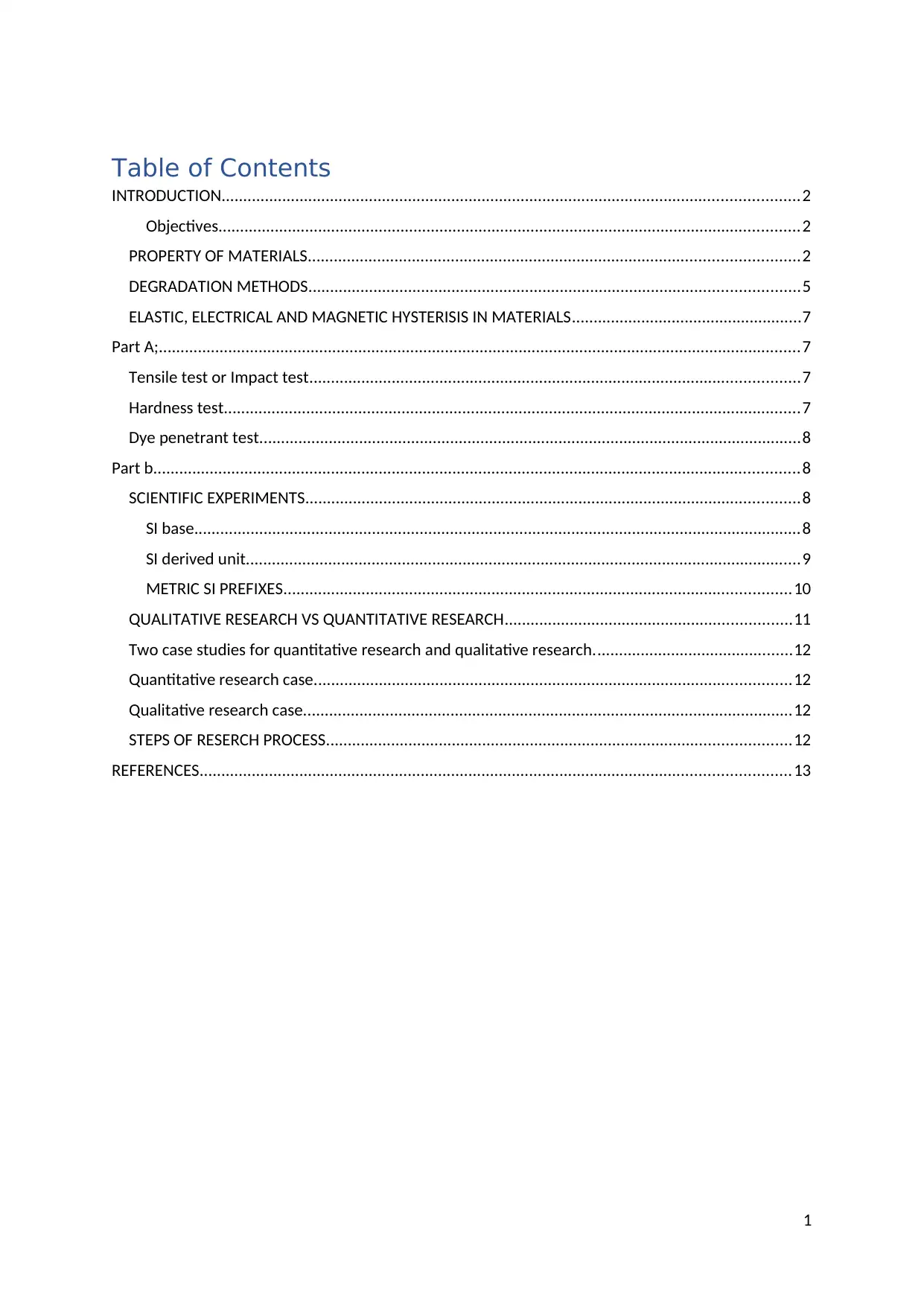
Table of Contents
INTRODUCTION.....................................................................................................................................2
Objectives......................................................................................................................................2
PROPERTY OF MATERIALS.................................................................................................................2
DEGRADATION METHODS.................................................................................................................5
ELASTIC, ELECTRICAL AND MAGNETIC HYSTERISIS IN MATERIALS.....................................................7
Part A;....................................................................................................................................................7
Tensile test or Impact test.................................................................................................................7
Hardness test.....................................................................................................................................7
Dye penetrant test.............................................................................................................................8
Part b.....................................................................................................................................................8
SCIENTIFIC EXPERIMENTS..................................................................................................................8
SI base............................................................................................................................................8
SI derived unit................................................................................................................................9
METRIC SI PREFIXES.....................................................................................................................10
QUALITATIVE RESEARCH VS QUANTITATIVE RESEARCH..................................................................11
Two case studies for quantitative research and qualitative research..............................................12
Quantitative research case..............................................................................................................12
Qualitative research case.................................................................................................................12
STEPS OF RESERCH PROCESS...........................................................................................................12
REFERENCES........................................................................................................................................13
1
INTRODUCTION.....................................................................................................................................2
Objectives......................................................................................................................................2
PROPERTY OF MATERIALS.................................................................................................................2
DEGRADATION METHODS.................................................................................................................5
ELASTIC, ELECTRICAL AND MAGNETIC HYSTERISIS IN MATERIALS.....................................................7
Part A;....................................................................................................................................................7
Tensile test or Impact test.................................................................................................................7
Hardness test.....................................................................................................................................7
Dye penetrant test.............................................................................................................................8
Part b.....................................................................................................................................................8
SCIENTIFIC EXPERIMENTS..................................................................................................................8
SI base............................................................................................................................................8
SI derived unit................................................................................................................................9
METRIC SI PREFIXES.....................................................................................................................10
QUALITATIVE RESEARCH VS QUANTITATIVE RESEARCH..................................................................11
Two case studies for quantitative research and qualitative research..............................................12
Quantitative research case..............................................................................................................12
Qualitative research case.................................................................................................................12
STEPS OF RESERCH PROCESS...........................................................................................................12
REFERENCES........................................................................................................................................13
1
Paraphrase This Document
Need a fresh take? Get an instant paraphrase of this document with our AI Paraphraser
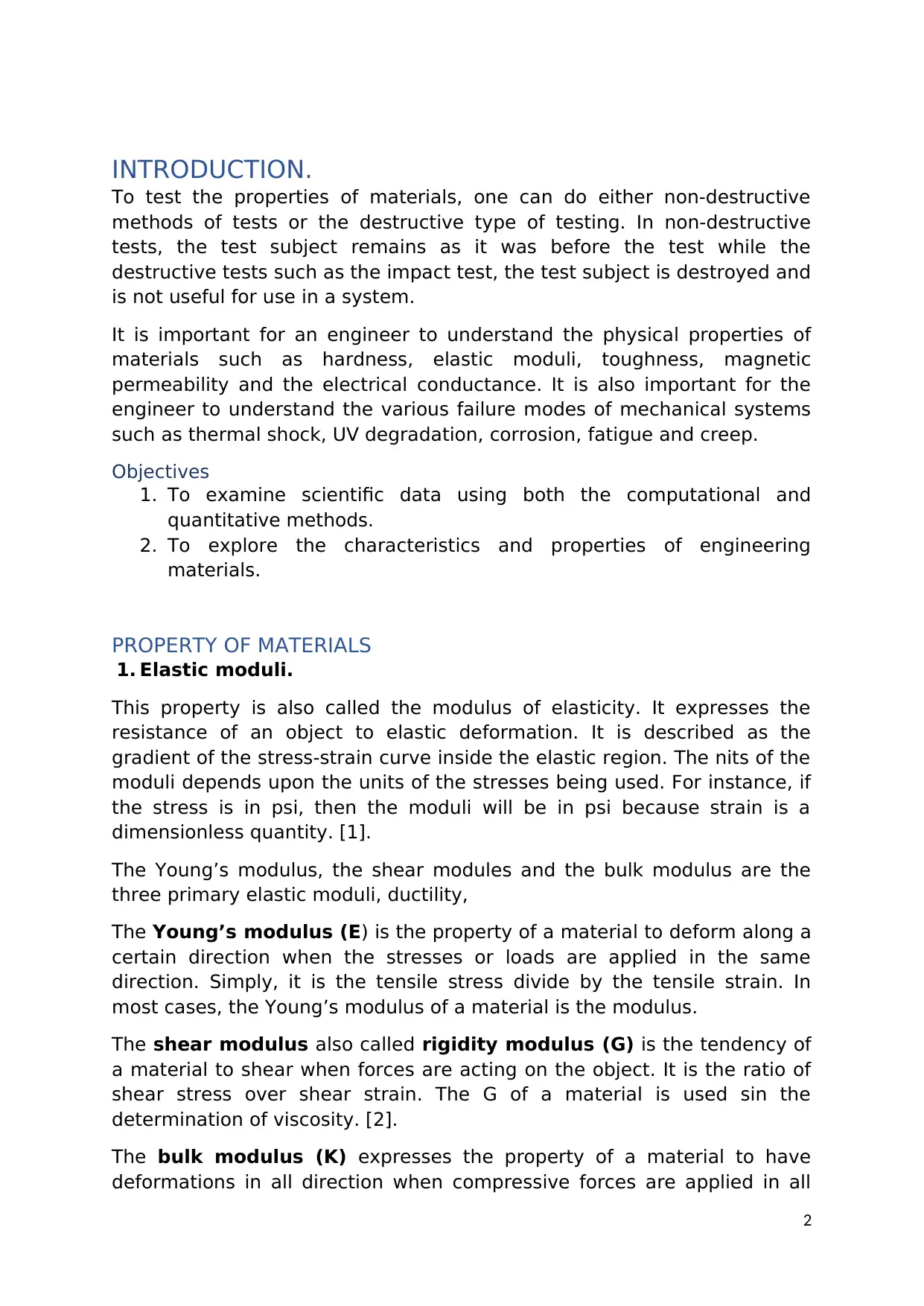
INTRODUCTION.
To test the properties of materials, one can do either non-destructive
methods of tests or the destructive type of testing. In non-destructive
tests, the test subject remains as it was before the test while the
destructive tests such as the impact test, the test subject is destroyed and
is not useful for use in a system.
It is important for an engineer to understand the physical properties of
materials such as hardness, elastic moduli, toughness, magnetic
permeability and the electrical conductance. It is also important for the
engineer to understand the various failure modes of mechanical systems
such as thermal shock, UV degradation, corrosion, fatigue and creep.
Objectives
1. To examine scientific data using both the computational and
quantitative methods.
2. To explore the characteristics and properties of engineering
materials.
PROPERTY OF MATERIALS
1. Elastic moduli.
This property is also called the modulus of elasticity. It expresses the
resistance of an object to elastic deformation. It is described as the
gradient of the stress-strain curve inside the elastic region. The nits of the
moduli depends upon the units of the stresses being used. For instance, if
the stress is in psi, then the moduli will be in psi because strain is a
dimensionless quantity. [1].
The Young’s modulus, the shear modules and the bulk modulus are the
three primary elastic moduli, ductility,
The Young’s modulus (E) is the property of a material to deform along a
certain direction when the stresses or loads are applied in the same
direction. Simply, it is the tensile stress divide by the tensile strain. In
most cases, the Young’s modulus of a material is the modulus.
The shear modulus also called rigidity modulus (G) is the tendency of
a material to shear when forces are acting on the object. It is the ratio of
shear stress over shear strain. The G of a material is used sin the
determination of viscosity. [2].
The bulk modulus (K) expresses the property of a material to have
deformations in all direction when compressive forces are applied in all
2
To test the properties of materials, one can do either non-destructive
methods of tests or the destructive type of testing. In non-destructive
tests, the test subject remains as it was before the test while the
destructive tests such as the impact test, the test subject is destroyed and
is not useful for use in a system.
It is important for an engineer to understand the physical properties of
materials such as hardness, elastic moduli, toughness, magnetic
permeability and the electrical conductance. It is also important for the
engineer to understand the various failure modes of mechanical systems
such as thermal shock, UV degradation, corrosion, fatigue and creep.
Objectives
1. To examine scientific data using both the computational and
quantitative methods.
2. To explore the characteristics and properties of engineering
materials.
PROPERTY OF MATERIALS
1. Elastic moduli.
This property is also called the modulus of elasticity. It expresses the
resistance of an object to elastic deformation. It is described as the
gradient of the stress-strain curve inside the elastic region. The nits of the
moduli depends upon the units of the stresses being used. For instance, if
the stress is in psi, then the moduli will be in psi because strain is a
dimensionless quantity. [1].
The Young’s modulus, the shear modules and the bulk modulus are the
three primary elastic moduli, ductility,
The Young’s modulus (E) is the property of a material to deform along a
certain direction when the stresses or loads are applied in the same
direction. Simply, it is the tensile stress divide by the tensile strain. In
most cases, the Young’s modulus of a material is the modulus.
The shear modulus also called rigidity modulus (G) is the tendency of
a material to shear when forces are acting on the object. It is the ratio of
shear stress over shear strain. The G of a material is used sin the
determination of viscosity. [2].
The bulk modulus (K) expresses the property of a material to have
deformations in all direction when compressive forces are applied in all
2

the direction. It is the ratio between the volumetric stresses to volumetric
strains. It is equal to the compressibility inverse.
2. Hardness.
Defines the material property to withstand plastic deformation caused by
abrasion or indentation. At atomic level, the hardness of a material is
subject to the intermolecular bonds. Hardness is usually high in materials
whose intermolecular bonds are strong. There are various methods of
measuring hardness, i.e. hardness to rebound, indentation hardness due
to indentation and hardness to scratch. Each type of hardness comes with
its way of measurement.
Scratch hardness, which is a measure of how well a material withstands
friction from other objects is measured on the Mohs scale. The tool used in
Mohs test is the sclerometer. A pocket hardness tester can also be used to
measure scratch hardness [3].
Indentation hardness is the most common hardness tested in engineering.
It measures the ability of a material to withstand constant compression
loads without deformation. The common scales used for this test are the
Brinell, Shore, Vickers, and Rockwell among others. [4].
Rebound hardness measures the bounce height of a hammer made in
diamond when dropped from a certain height to an object. A scleroscope
is used to measure rebound hardness. If a material is hard, then the
material will resist deformation and most of the kinetic energy would be
used in bouncing. There are two scales used to measure the rebound
hardness namely; the Bennet hardness scale and the Leeb rebound
hardness. [2].
3. Ductility
The material’s ability to deform plastically before yielding expressed in
percentage elongation or the percentage of the reduction area of the
material after testing. It is commonly associated with the ability of a
material to form wires when loaded with tensile forces. During testing,
rapture must satisfy some conditions. The elongation to failure must be
bigger or equal to 5% or the area reduction must be greater or equal to
20% or the true strain to rapture be 10%. [5].
The material’s ability to withstand plastic deformation under compression
is called Malleability. It is commonly associated with the ability of a
material to be compressed to form sheets.
Both ductility and malleability measures plasticity. They are affected by
the operating temperatures and pressure. Some materials may do well in
both ductility and malleability while others may do well only in one
3
strains. It is equal to the compressibility inverse.
2. Hardness.
Defines the material property to withstand plastic deformation caused by
abrasion or indentation. At atomic level, the hardness of a material is
subject to the intermolecular bonds. Hardness is usually high in materials
whose intermolecular bonds are strong. There are various methods of
measuring hardness, i.e. hardness to rebound, indentation hardness due
to indentation and hardness to scratch. Each type of hardness comes with
its way of measurement.
Scratch hardness, which is a measure of how well a material withstands
friction from other objects is measured on the Mohs scale. The tool used in
Mohs test is the sclerometer. A pocket hardness tester can also be used to
measure scratch hardness [3].
Indentation hardness is the most common hardness tested in engineering.
It measures the ability of a material to withstand constant compression
loads without deformation. The common scales used for this test are the
Brinell, Shore, Vickers, and Rockwell among others. [4].
Rebound hardness measures the bounce height of a hammer made in
diamond when dropped from a certain height to an object. A scleroscope
is used to measure rebound hardness. If a material is hard, then the
material will resist deformation and most of the kinetic energy would be
used in bouncing. There are two scales used to measure the rebound
hardness namely; the Bennet hardness scale and the Leeb rebound
hardness. [2].
3. Ductility
The material’s ability to deform plastically before yielding expressed in
percentage elongation or the percentage of the reduction area of the
material after testing. It is commonly associated with the ability of a
material to form wires when loaded with tensile forces. During testing,
rapture must satisfy some conditions. The elongation to failure must be
bigger or equal to 5% or the area reduction must be greater or equal to
20% or the true strain to rapture be 10%. [5].
The material’s ability to withstand plastic deformation under compression
is called Malleability. It is commonly associated with the ability of a
material to be compressed to form sheets.
Both ductility and malleability measures plasticity. They are affected by
the operating temperatures and pressure. Some materials may do well in
both ductility and malleability while others may do well only in one
3
⊘ This is a preview!⊘
Do you want full access?
Subscribe today to unlock all pages.

Trusted by 1+ million students worldwide
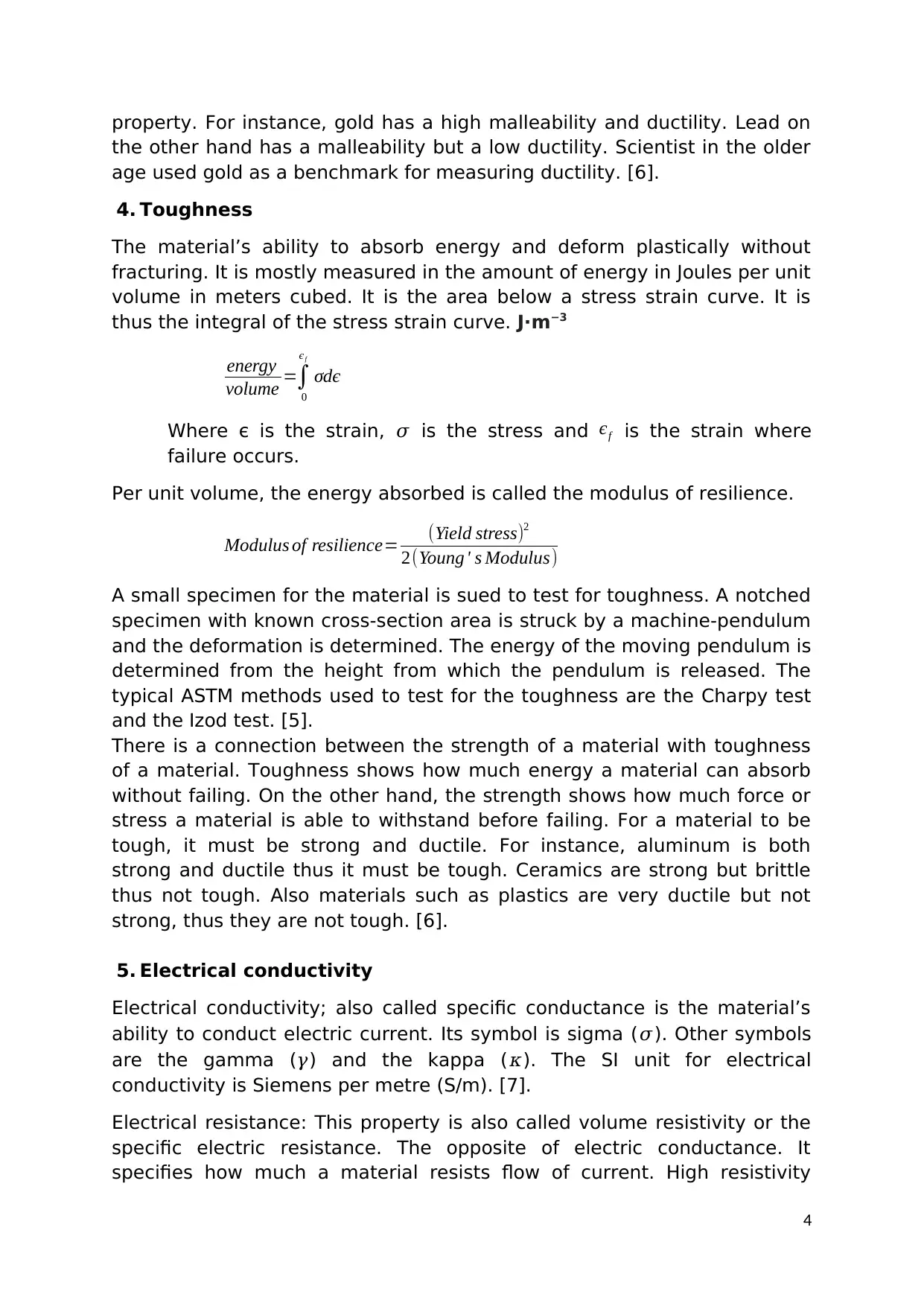
property. For instance, gold has a high malleability and ductility. Lead on
the other hand has a malleability but a low ductility. Scientist in the older
age used gold as a benchmark for measuring ductility. [6].
4. Toughness
The material’s ability to absorb energy and deform plastically without
fracturing. It is mostly measured in the amount of energy in Joules per unit
volume in meters cubed. It is the area below a stress strain curve. It is
thus the integral of the stress strain curve. J·m−3
energy
volume =∫
0
єf
σdє
Where є is the strain, 𝜎 is the stress and єf is the strain where
failure occurs.
Per unit volume, the energy absorbed is called the modulus of resilience.
Modulus of resilience= (Yield stress)2
2(Young ' s Modulus)
A small specimen for the material is sued to test for toughness. A notched
specimen with known cross-section area is struck by a machine-pendulum
and the deformation is determined. The energy of the moving pendulum is
determined from the height from which the pendulum is released. The
typical ASTM methods used to test for the toughness are the Charpy test
and the Izod test. [5].
There is a connection between the strength of a material with toughness
of a material. Toughness shows how much energy a material can absorb
without failing. On the other hand, the strength shows how much force or
stress a material is able to withstand before failing. For a material to be
tough, it must be strong and ductile. For instance, aluminum is both
strong and ductile thus it must be tough. Ceramics are strong but brittle
thus not tough. Also materials such as plastics are very ductile but not
strong, thus they are not tough. [6].
5. Electrical conductivity
Electrical conductivity; also called specific conductance is the material’s
ability to conduct electric current. Its symbol is sigma (𝜎). Other symbols
are the gamma (𝛾) and the kappa (𝜅). The SI unit for electrical
conductivity is Siemens per metre (S/m). [7].
Electrical resistance: This property is also called volume resistivity or the
specific electric resistance. The opposite of electric conductance. It
specifies how much a material resists flow of current. High resistivity
4
the other hand has a malleability but a low ductility. Scientist in the older
age used gold as a benchmark for measuring ductility. [6].
4. Toughness
The material’s ability to absorb energy and deform plastically without
fracturing. It is mostly measured in the amount of energy in Joules per unit
volume in meters cubed. It is the area below a stress strain curve. It is
thus the integral of the stress strain curve. J·m−3
energy
volume =∫
0
єf
σdє
Where є is the strain, 𝜎 is the stress and єf is the strain where
failure occurs.
Per unit volume, the energy absorbed is called the modulus of resilience.
Modulus of resilience= (Yield stress)2
2(Young ' s Modulus)
A small specimen for the material is sued to test for toughness. A notched
specimen with known cross-section area is struck by a machine-pendulum
and the deformation is determined. The energy of the moving pendulum is
determined from the height from which the pendulum is released. The
typical ASTM methods used to test for the toughness are the Charpy test
and the Izod test. [5].
There is a connection between the strength of a material with toughness
of a material. Toughness shows how much energy a material can absorb
without failing. On the other hand, the strength shows how much force or
stress a material is able to withstand before failing. For a material to be
tough, it must be strong and ductile. For instance, aluminum is both
strong and ductile thus it must be tough. Ceramics are strong but brittle
thus not tough. Also materials such as plastics are very ductile but not
strong, thus they are not tough. [6].
5. Electrical conductivity
Electrical conductivity; also called specific conductance is the material’s
ability to conduct electric current. Its symbol is sigma (𝜎). Other symbols
are the gamma (𝛾) and the kappa (𝜅). The SI unit for electrical
conductivity is Siemens per metre (S/m). [7].
Electrical resistance: This property is also called volume resistivity or the
specific electric resistance. The opposite of electric conductance. It
specifies how much a material resists flow of current. High resistivity
4
Paraphrase This Document
Need a fresh take? Get an instant paraphrase of this document with our AI Paraphraser
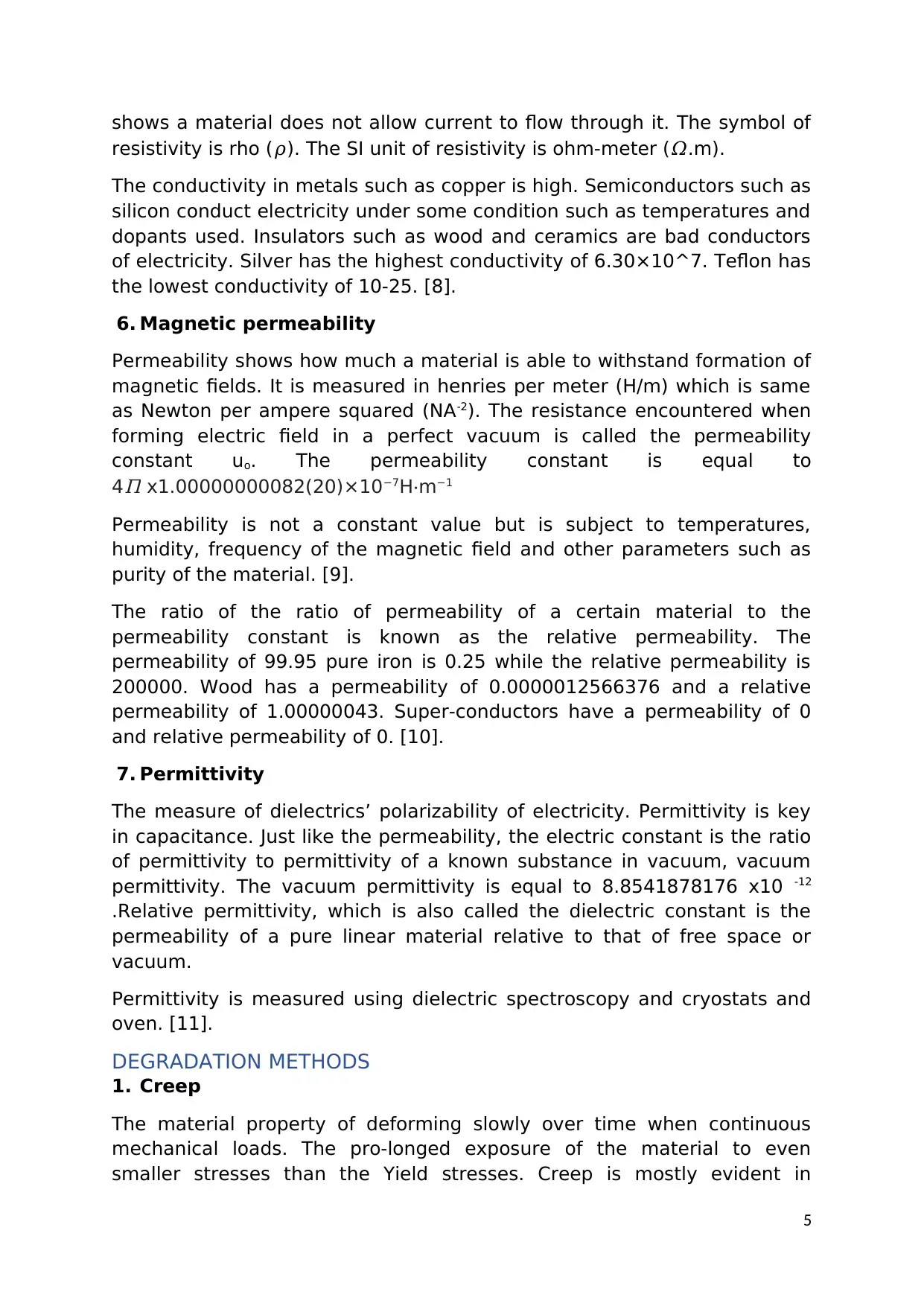
shows a material does not allow current to flow through it. The symbol of
resistivity is rho (𝜌). The SI unit of resistivity is ohm-meter (𝛺.m).
The conductivity in metals such as copper is high. Semiconductors such as
silicon conduct electricity under some condition such as temperatures and
dopants used. Insulators such as wood and ceramics are bad conductors
of electricity. Silver has the highest conductivity of 6.30×10^7. Teflon has
the lowest conductivity of 10-25. [8].
6. Magnetic permeability
Permeability shows how much a material is able to withstand formation of
magnetic fields. It is measured in henries per meter (H/m) which is same
as Newton per ampere squared (NA-2). The resistance encountered when
forming electric field in a perfect vacuum is called the permeability
constant uo. The permeability constant is equal to
4
Π x1.00000000082(20)×10−7H⋅m−1
Permeability is not a constant value but is subject to temperatures,
humidity, frequency of the magnetic field and other parameters such as
purity of the material. [9].
The ratio of the ratio of permeability of a certain material to the
permeability constant is known as the relative permeability. The
permeability of 99.95 pure iron is 0.25 while the relative permeability is
200000. Wood has a permeability of 0.0000012566376 and a relative
permeability of 1.00000043. Super-conductors have a permeability of 0
and relative permeability of 0. [10].
7. Permittivity
The measure of dielectrics’ polarizability of electricity. Permittivity is key
in capacitance. Just like the permeability, the electric constant is the ratio
of permittivity to permittivity of a known substance in vacuum, vacuum
permittivity. The vacuum permittivity is equal to 8.8541878176 x10 -12
.Relative permittivity, which is also called the dielectric constant is the
permeability of a pure linear material relative to that of free space or
vacuum.
Permittivity is measured using dielectric spectroscopy and cryostats and
oven. [11].
DEGRADATION METHODS
1. Creep
The material property of deforming slowly over time when continuous
mechanical loads. The pro-longed exposure of the material to even
smaller stresses than the Yield stresses. Creep is mostly evident in
5
resistivity is rho (𝜌). The SI unit of resistivity is ohm-meter (𝛺.m).
The conductivity in metals such as copper is high. Semiconductors such as
silicon conduct electricity under some condition such as temperatures and
dopants used. Insulators such as wood and ceramics are bad conductors
of electricity. Silver has the highest conductivity of 6.30×10^7. Teflon has
the lowest conductivity of 10-25. [8].
6. Magnetic permeability
Permeability shows how much a material is able to withstand formation of
magnetic fields. It is measured in henries per meter (H/m) which is same
as Newton per ampere squared (NA-2). The resistance encountered when
forming electric field in a perfect vacuum is called the permeability
constant uo. The permeability constant is equal to
4
Π x1.00000000082(20)×10−7H⋅m−1
Permeability is not a constant value but is subject to temperatures,
humidity, frequency of the magnetic field and other parameters such as
purity of the material. [9].
The ratio of the ratio of permeability of a certain material to the
permeability constant is known as the relative permeability. The
permeability of 99.95 pure iron is 0.25 while the relative permeability is
200000. Wood has a permeability of 0.0000012566376 and a relative
permeability of 1.00000043. Super-conductors have a permeability of 0
and relative permeability of 0. [10].
7. Permittivity
The measure of dielectrics’ polarizability of electricity. Permittivity is key
in capacitance. Just like the permeability, the electric constant is the ratio
of permittivity to permittivity of a known substance in vacuum, vacuum
permittivity. The vacuum permittivity is equal to 8.8541878176 x10 -12
.Relative permittivity, which is also called the dielectric constant is the
permeability of a pure linear material relative to that of free space or
vacuum.
Permittivity is measured using dielectric spectroscopy and cryostats and
oven. [11].
DEGRADATION METHODS
1. Creep
The material property of deforming slowly over time when continuous
mechanical loads. The pro-longed exposure of the material to even
smaller stresses than the Yield stresses. Creep is mostly evident in
5
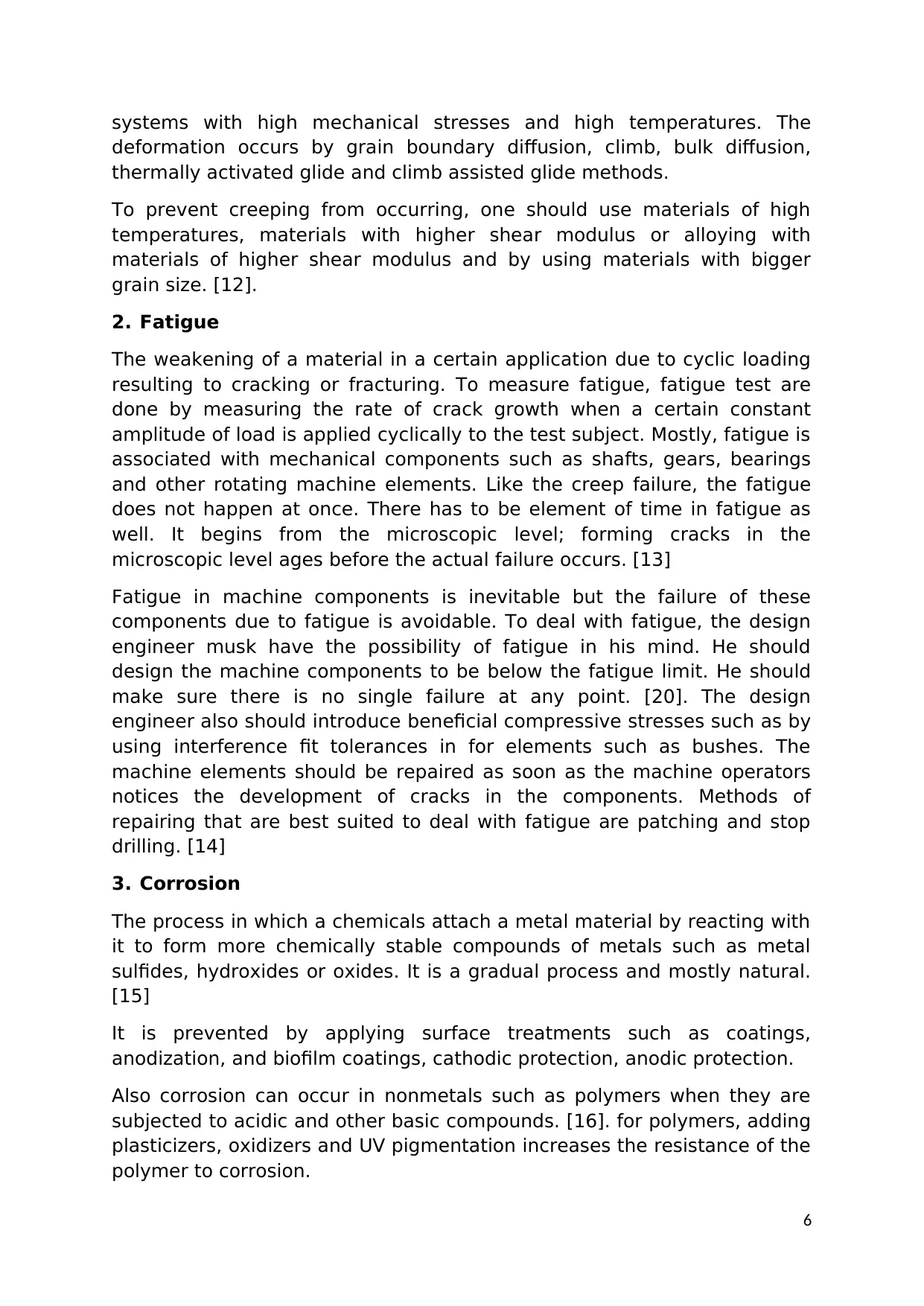
systems with high mechanical stresses and high temperatures. The
deformation occurs by grain boundary diffusion, climb, bulk diffusion,
thermally activated glide and climb assisted glide methods.
To prevent creeping from occurring, one should use materials of high
temperatures, materials with higher shear modulus or alloying with
materials of higher shear modulus and by using materials with bigger
grain size. [12].
2. Fatigue
The weakening of a material in a certain application due to cyclic loading
resulting to cracking or fracturing. To measure fatigue, fatigue test are
done by measuring the rate of crack growth when a certain constant
amplitude of load is applied cyclically to the test subject. Mostly, fatigue is
associated with mechanical components such as shafts, gears, bearings
and other rotating machine elements. Like the creep failure, the fatigue
does not happen at once. There has to be element of time in fatigue as
well. It begins from the microscopic level; forming cracks in the
microscopic level ages before the actual failure occurs. [13]
Fatigue in machine components is inevitable but the failure of these
components due to fatigue is avoidable. To deal with fatigue, the design
engineer musk have the possibility of fatigue in his mind. He should
design the machine components to be below the fatigue limit. He should
make sure there is no single failure at any point. [20]. The design
engineer also should introduce beneficial compressive stresses such as by
using interference fit tolerances in for elements such as bushes. The
machine elements should be repaired as soon as the machine operators
notices the development of cracks in the components. Methods of
repairing that are best suited to deal with fatigue are patching and stop
drilling. [14]
3. Corrosion
The process in which a chemicals attach a metal material by reacting with
it to form more chemically stable compounds of metals such as metal
sulfides, hydroxides or oxides. It is a gradual process and mostly natural.
[15]
It is prevented by applying surface treatments such as coatings,
anodization, and biofilm coatings, cathodic protection, anodic protection.
Also corrosion can occur in nonmetals such as polymers when they are
subjected to acidic and other basic compounds. [16]. for polymers, adding
plasticizers, oxidizers and UV pigmentation increases the resistance of the
polymer to corrosion.
6
deformation occurs by grain boundary diffusion, climb, bulk diffusion,
thermally activated glide and climb assisted glide methods.
To prevent creeping from occurring, one should use materials of high
temperatures, materials with higher shear modulus or alloying with
materials of higher shear modulus and by using materials with bigger
grain size. [12].
2. Fatigue
The weakening of a material in a certain application due to cyclic loading
resulting to cracking or fracturing. To measure fatigue, fatigue test are
done by measuring the rate of crack growth when a certain constant
amplitude of load is applied cyclically to the test subject. Mostly, fatigue is
associated with mechanical components such as shafts, gears, bearings
and other rotating machine elements. Like the creep failure, the fatigue
does not happen at once. There has to be element of time in fatigue as
well. It begins from the microscopic level; forming cracks in the
microscopic level ages before the actual failure occurs. [13]
Fatigue in machine components is inevitable but the failure of these
components due to fatigue is avoidable. To deal with fatigue, the design
engineer musk have the possibility of fatigue in his mind. He should
design the machine components to be below the fatigue limit. He should
make sure there is no single failure at any point. [20]. The design
engineer also should introduce beneficial compressive stresses such as by
using interference fit tolerances in for elements such as bushes. The
machine elements should be repaired as soon as the machine operators
notices the development of cracks in the components. Methods of
repairing that are best suited to deal with fatigue are patching and stop
drilling. [14]
3. Corrosion
The process in which a chemicals attach a metal material by reacting with
it to form more chemically stable compounds of metals such as metal
sulfides, hydroxides or oxides. It is a gradual process and mostly natural.
[15]
It is prevented by applying surface treatments such as coatings,
anodization, and biofilm coatings, cathodic protection, anodic protection.
Also corrosion can occur in nonmetals such as polymers when they are
subjected to acidic and other basic compounds. [16]. for polymers, adding
plasticizers, oxidizers and UV pigmentation increases the resistance of the
polymer to corrosion.
6
⊘ This is a preview!⊘
Do you want full access?
Subscribe today to unlock all pages.

Trusted by 1+ million students worldwide
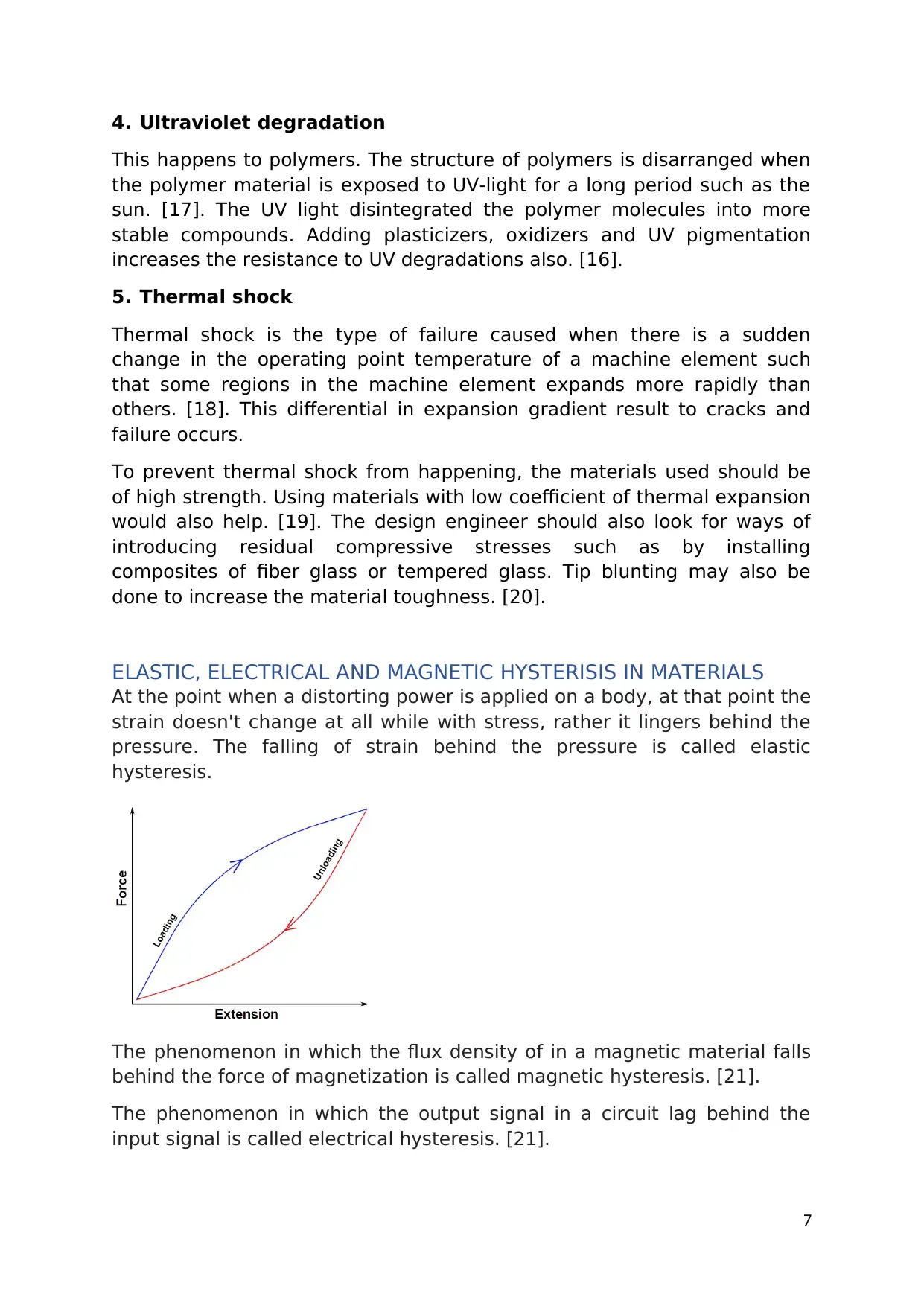
4. Ultraviolet degradation
This happens to polymers. The structure of polymers is disarranged when
the polymer material is exposed to UV-light for a long period such as the
sun. [17]. The UV light disintegrated the polymer molecules into more
stable compounds. Adding plasticizers, oxidizers and UV pigmentation
increases the resistance to UV degradations also. [16].
5. Thermal shock
Thermal shock is the type of failure caused when there is a sudden
change in the operating point temperature of a machine element such
that some regions in the machine element expands more rapidly than
others. [18]. This differential in expansion gradient result to cracks and
failure occurs.
To prevent thermal shock from happening, the materials used should be
of high strength. Using materials with low coefficient of thermal expansion
would also help. [19]. The design engineer should also look for ways of
introducing residual compressive stresses such as by installing
composites of fiber glass or tempered glass. Tip blunting may also be
done to increase the material toughness. [20].
ELASTIC, ELECTRICAL AND MAGNETIC HYSTERISIS IN MATERIALS
At the point when a distorting power is applied on a body, at that point the
strain doesn't change at all while with stress, rather it lingers behind the
pressure. The falling of strain behind the pressure is called elastic
hysteresis.
The phenomenon in which the flux density of in a magnetic material falls
behind the force of magnetization is called magnetic hysteresis. [21].
The phenomenon in which the output signal in a circuit lag behind the
input signal is called electrical hysteresis. [21].
7
This happens to polymers. The structure of polymers is disarranged when
the polymer material is exposed to UV-light for a long period such as the
sun. [17]. The UV light disintegrated the polymer molecules into more
stable compounds. Adding plasticizers, oxidizers and UV pigmentation
increases the resistance to UV degradations also. [16].
5. Thermal shock
Thermal shock is the type of failure caused when there is a sudden
change in the operating point temperature of a machine element such
that some regions in the machine element expands more rapidly than
others. [18]. This differential in expansion gradient result to cracks and
failure occurs.
To prevent thermal shock from happening, the materials used should be
of high strength. Using materials with low coefficient of thermal expansion
would also help. [19]. The design engineer should also look for ways of
introducing residual compressive stresses such as by installing
composites of fiber glass or tempered glass. Tip blunting may also be
done to increase the material toughness. [20].
ELASTIC, ELECTRICAL AND MAGNETIC HYSTERISIS IN MATERIALS
At the point when a distorting power is applied on a body, at that point the
strain doesn't change at all while with stress, rather it lingers behind the
pressure. The falling of strain behind the pressure is called elastic
hysteresis.
The phenomenon in which the flux density of in a magnetic material falls
behind the force of magnetization is called magnetic hysteresis. [21].
The phenomenon in which the output signal in a circuit lag behind the
input signal is called electrical hysteresis. [21].
7
Paraphrase This Document
Need a fresh take? Get an instant paraphrase of this document with our AI Paraphraser
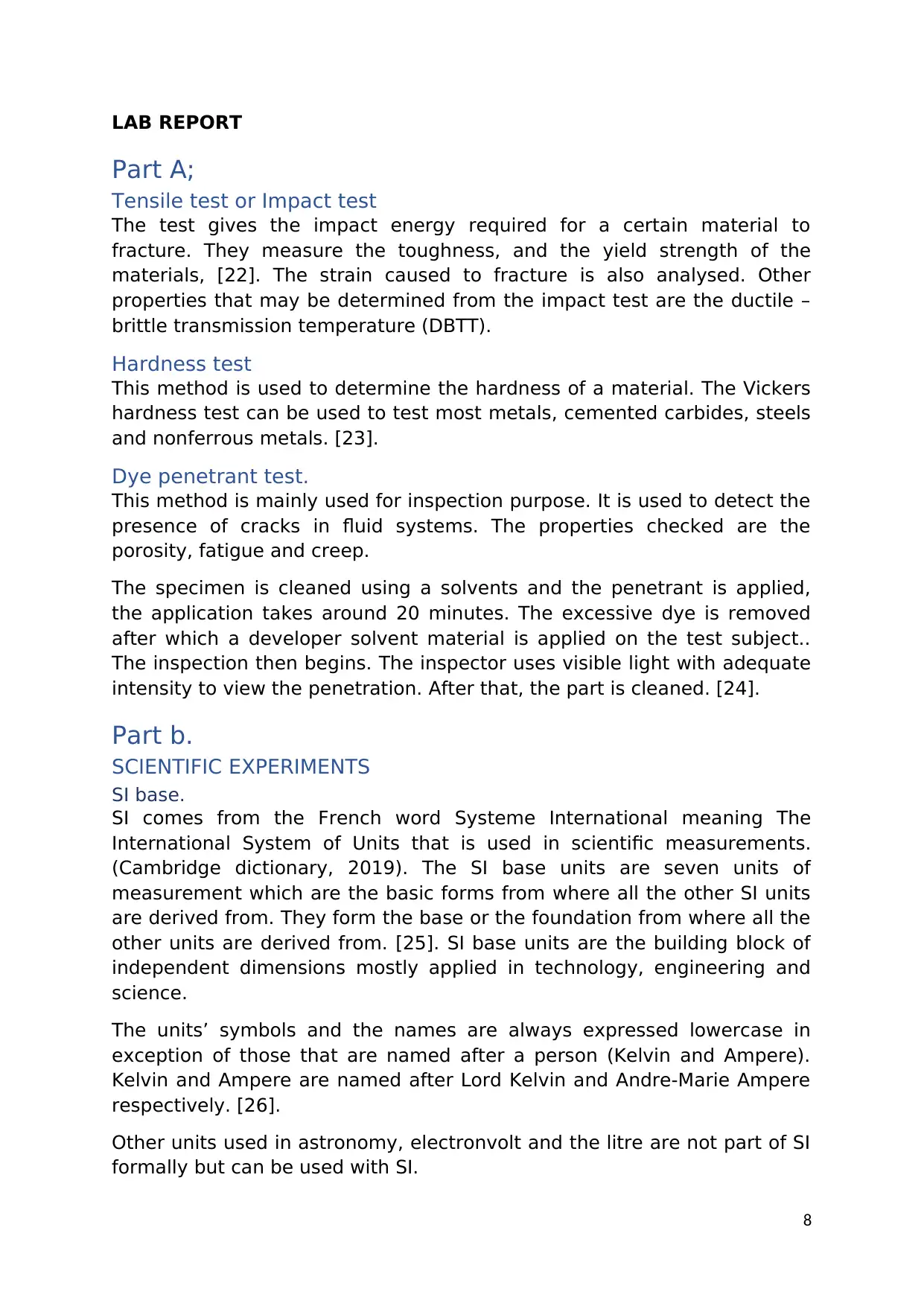
LAB REPORT
Part A;
Tensile test or Impact test
The test gives the impact energy required for a certain material to
fracture. They measure the toughness, and the yield strength of the
materials, [22]. The strain caused to fracture is also analysed. Other
properties that may be determined from the impact test are the ductile –
brittle transmission temperature (DBTT).
Hardness test
This method is used to determine the hardness of a material. The Vickers
hardness test can be used to test most metals, cemented carbides, steels
and nonferrous metals. [23].
Dye penetrant test.
This method is mainly used for inspection purpose. It is used to detect the
presence of cracks in fluid systems. The properties checked are the
porosity, fatigue and creep.
The specimen is cleaned using a solvents and the penetrant is applied,
the application takes around 20 minutes. The excessive dye is removed
after which a developer solvent material is applied on the test subject..
The inspection then begins. The inspector uses visible light with adequate
intensity to view the penetration. After that, the part is cleaned. [24].
Part b.
SCIENTIFIC EXPERIMENTS
SI base.
SI comes from the French word Systeme International meaning The
International System of Units that is used in scientific measurements.
(Cambridge dictionary, 2019). The SI base units are seven units of
measurement which are the basic forms from where all the other SI units
are derived from. They form the base or the foundation from where all the
other units are derived from. [25]. SI base units are the building block of
independent dimensions mostly applied in technology, engineering and
science.
The units’ symbols and the names are always expressed lowercase in
exception of those that are named after a person (Kelvin and Ampere).
Kelvin and Ampere are named after Lord Kelvin and Andre-Marie Ampere
respectively. [26].
Other units used in astronomy, electronvolt and the litre are not part of SI
formally but can be used with SI.
8
Part A;
Tensile test or Impact test
The test gives the impact energy required for a certain material to
fracture. They measure the toughness, and the yield strength of the
materials, [22]. The strain caused to fracture is also analysed. Other
properties that may be determined from the impact test are the ductile –
brittle transmission temperature (DBTT).
Hardness test
This method is used to determine the hardness of a material. The Vickers
hardness test can be used to test most metals, cemented carbides, steels
and nonferrous metals. [23].
Dye penetrant test.
This method is mainly used for inspection purpose. It is used to detect the
presence of cracks in fluid systems. The properties checked are the
porosity, fatigue and creep.
The specimen is cleaned using a solvents and the penetrant is applied,
the application takes around 20 minutes. The excessive dye is removed
after which a developer solvent material is applied on the test subject..
The inspection then begins. The inspector uses visible light with adequate
intensity to view the penetration. After that, the part is cleaned. [24].
Part b.
SCIENTIFIC EXPERIMENTS
SI base.
SI comes from the French word Systeme International meaning The
International System of Units that is used in scientific measurements.
(Cambridge dictionary, 2019). The SI base units are seven units of
measurement which are the basic forms from where all the other SI units
are derived from. They form the base or the foundation from where all the
other units are derived from. [25]. SI base units are the building block of
independent dimensions mostly applied in technology, engineering and
science.
The units’ symbols and the names are always expressed lowercase in
exception of those that are named after a person (Kelvin and Ampere).
Kelvin and Ampere are named after Lord Kelvin and Andre-Marie Ampere
respectively. [26].
Other units used in astronomy, electronvolt and the litre are not part of SI
formally but can be used with SI.
8
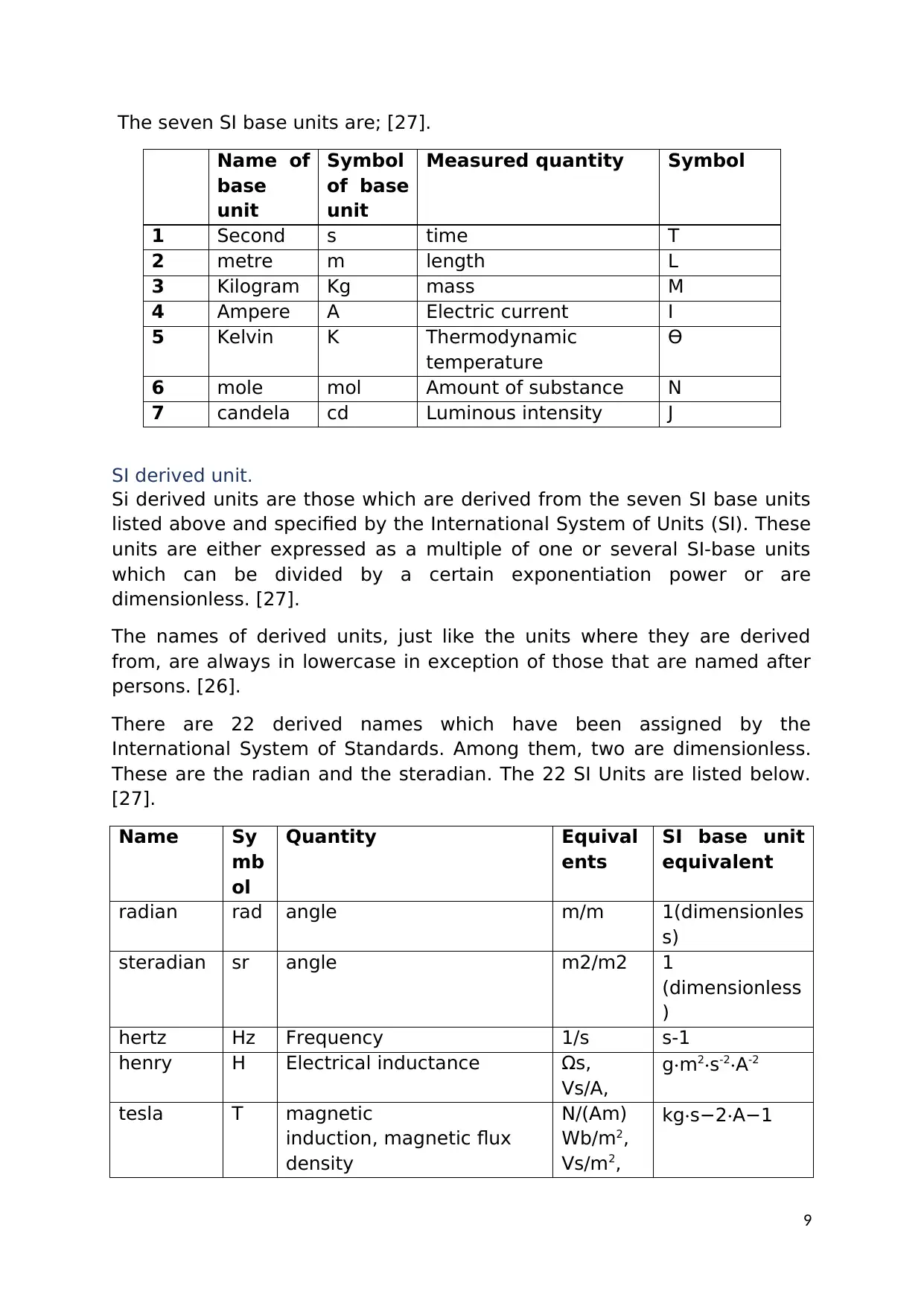
The seven SI base units are; [27].
Name of
base
unit
Symbol
of base
unit
Measured quantity Symbol
1 Second s time T
2 metre m length L
3 Kilogram Kg mass M
4 Ampere A Electric current I
5 Kelvin K Thermodynamic
temperature
Ɵ
6 mole mol Amount of substance N
7 candela cd Luminous intensity J
SI derived unit.
Si derived units are those which are derived from the seven SI base units
listed above and specified by the International System of Units (SI). These
units are either expressed as a multiple of one or several SI-base units
which can be divided by a certain exponentiation power or are
dimensionless. [27].
The names of derived units, just like the units where they are derived
from, are always in lowercase in exception of those that are named after
persons. [26].
There are 22 derived names which have been assigned by the
International System of Standards. Among them, two are dimensionless.
These are the radian and the steradian. The 22 SI Units are listed below.
[27].
Name Sy
mb
ol
Quantity Equival
ents
SI base unit
equivalent
radian rad angle m/m 1(dimensionles
s)
steradian sr angle m2/m2 1
(dimensionless
)
hertz Hz Frequency 1/s s-1
henry H Electrical inductance Ωs,
Vs/A,
g⋅m2⋅s-2⋅A-2
tesla T magnetic
induction, magnetic flux
density
N/(Am)
Wb/m2,
Vs/m2,
kg⋅s−2⋅A−1
9
Name of
base
unit
Symbol
of base
unit
Measured quantity Symbol
1 Second s time T
2 metre m length L
3 Kilogram Kg mass M
4 Ampere A Electric current I
5 Kelvin K Thermodynamic
temperature
Ɵ
6 mole mol Amount of substance N
7 candela cd Luminous intensity J
SI derived unit.
Si derived units are those which are derived from the seven SI base units
listed above and specified by the International System of Units (SI). These
units are either expressed as a multiple of one or several SI-base units
which can be divided by a certain exponentiation power or are
dimensionless. [27].
The names of derived units, just like the units where they are derived
from, are always in lowercase in exception of those that are named after
persons. [26].
There are 22 derived names which have been assigned by the
International System of Standards. Among them, two are dimensionless.
These are the radian and the steradian. The 22 SI Units are listed below.
[27].
Name Sy
mb
ol
Quantity Equival
ents
SI base unit
equivalent
radian rad angle m/m 1(dimensionles
s)
steradian sr angle m2/m2 1
(dimensionless
)
hertz Hz Frequency 1/s s-1
henry H Electrical inductance Ωs,
Vs/A,
g⋅m2⋅s-2⋅A-2
tesla T magnetic
induction, magnetic flux
density
N/(Am)
Wb/m2,
Vs/m2,
kg⋅s−2⋅A−1
9
⊘ This is a preview!⊘
Do you want full access?
Subscribe today to unlock all pages.

Trusted by 1+ million students worldwide
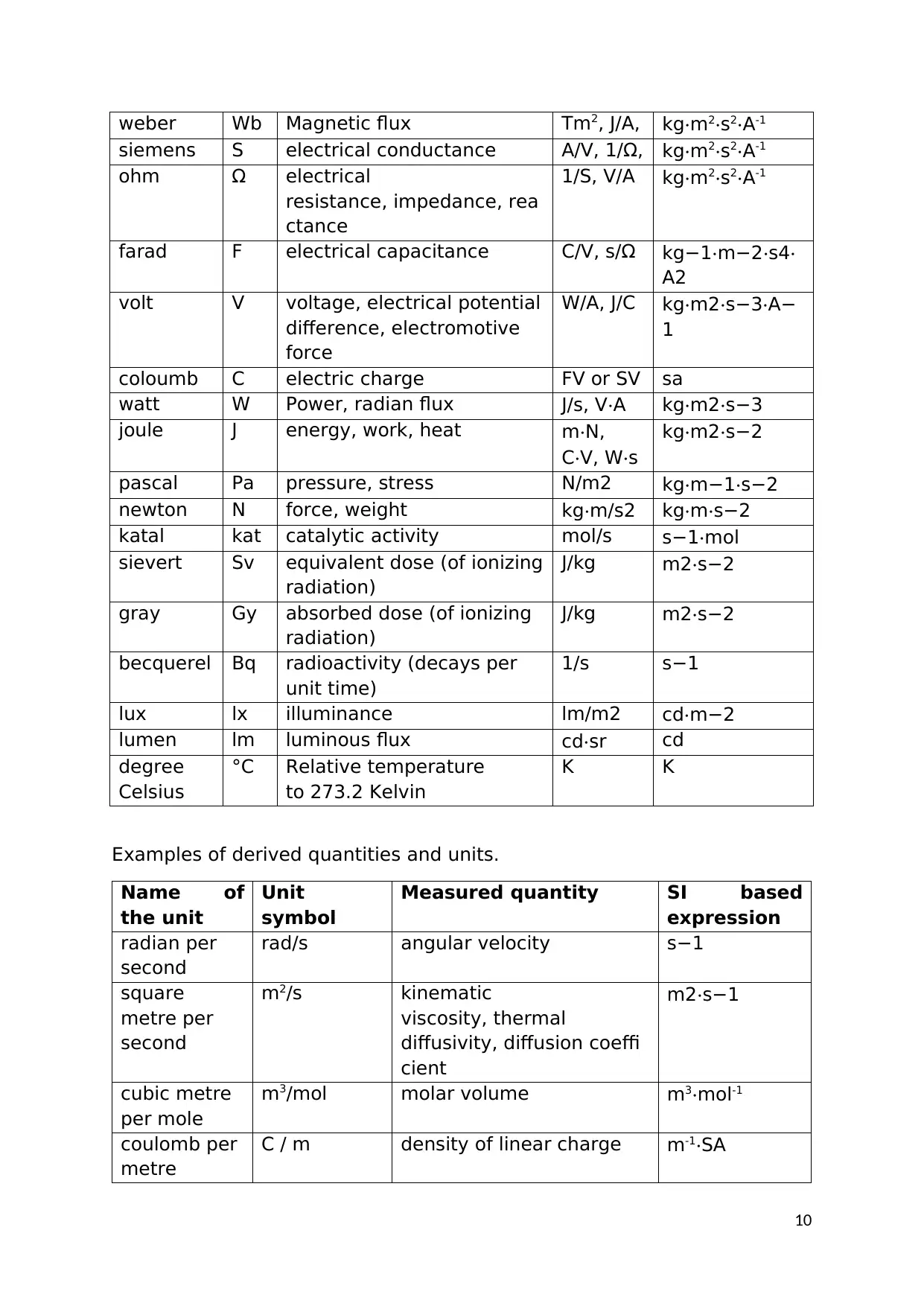
weber Wb Magnetic flux Tm2, J/A, kg⋅m2⋅s2⋅A-1
siemens S electrical conductance A/V, 1/Ω, kg⋅m2⋅s2⋅A-1
ohm Ω electrical
resistance, impedance, rea
ctance
1/S, V/A kg⋅m2⋅s2⋅A-1
farad F electrical capacitance C/V, s/Ω kg−1⋅m−2⋅s4⋅
A2
volt V voltage, electrical potential
difference, electromotive
force
W/A, J/C kg⋅m2⋅s−3⋅A−
1
coloumb C electric charge FV or SV sa
watt W Power, radian flux J/s, V⋅A kg⋅m2⋅s−3
joule J energy, work, heat m⋅N,
C⋅V, W⋅s
kg⋅m2⋅s−2
pascal Pa pressure, stress N/m2 kg⋅m−1⋅s−2
newton N force, weight kg⋅m/s2 kg⋅m⋅s−2
katal kat catalytic activity mol/s s−1⋅mol
sievert Sv equivalent dose (of ionizing
radiation)
J/kg m2⋅s−2
gray Gy absorbed dose (of ionizing
radiation)
J/kg m2⋅s−2
becquerel Bq radioactivity (decays per
unit time)
1/s s−1
lux lx illuminance lm/m2 cd⋅m−2
lumen lm luminous flux cd⋅sr cd
degree
Celsius
°C Relative temperature
to 273.2 Kelvin
K K
Examples of derived quantities and units.
Name of
the unit
Unit
symbol
Measured quantity SI based
expression
radian per
second
rad/s angular velocity s−1
square
metre per
second
m2/s kinematic
viscosity, thermal
diffusivity, diffusion coeffi
cient
m2⋅s−1
cubic metre
per mole
m3/mol molar volume m3⋅mol-1
coulomb per
metre
C / m density of linear charge m-1⋅SA
10
siemens S electrical conductance A/V, 1/Ω, kg⋅m2⋅s2⋅A-1
ohm Ω electrical
resistance, impedance, rea
ctance
1/S, V/A kg⋅m2⋅s2⋅A-1
farad F electrical capacitance C/V, s/Ω kg−1⋅m−2⋅s4⋅
A2
volt V voltage, electrical potential
difference, electromotive
force
W/A, J/C kg⋅m2⋅s−3⋅A−
1
coloumb C electric charge FV or SV sa
watt W Power, radian flux J/s, V⋅A kg⋅m2⋅s−3
joule J energy, work, heat m⋅N,
C⋅V, W⋅s
kg⋅m2⋅s−2
pascal Pa pressure, stress N/m2 kg⋅m−1⋅s−2
newton N force, weight kg⋅m/s2 kg⋅m⋅s−2
katal kat catalytic activity mol/s s−1⋅mol
sievert Sv equivalent dose (of ionizing
radiation)
J/kg m2⋅s−2
gray Gy absorbed dose (of ionizing
radiation)
J/kg m2⋅s−2
becquerel Bq radioactivity (decays per
unit time)
1/s s−1
lux lx illuminance lm/m2 cd⋅m−2
lumen lm luminous flux cd⋅sr cd
degree
Celsius
°C Relative temperature
to 273.2 Kelvin
K K
Examples of derived quantities and units.
Name of
the unit
Unit
symbol
Measured quantity SI based
expression
radian per
second
rad/s angular velocity s−1
square
metre per
second
m2/s kinematic
viscosity, thermal
diffusivity, diffusion coeffi
cient
m2⋅s−1
cubic metre
per mole
m3/mol molar volume m3⋅mol-1
coulomb per
metre
C / m density of linear charge m-1⋅SA
10
Paraphrase This Document
Need a fresh take? Get an instant paraphrase of this document with our AI Paraphraser
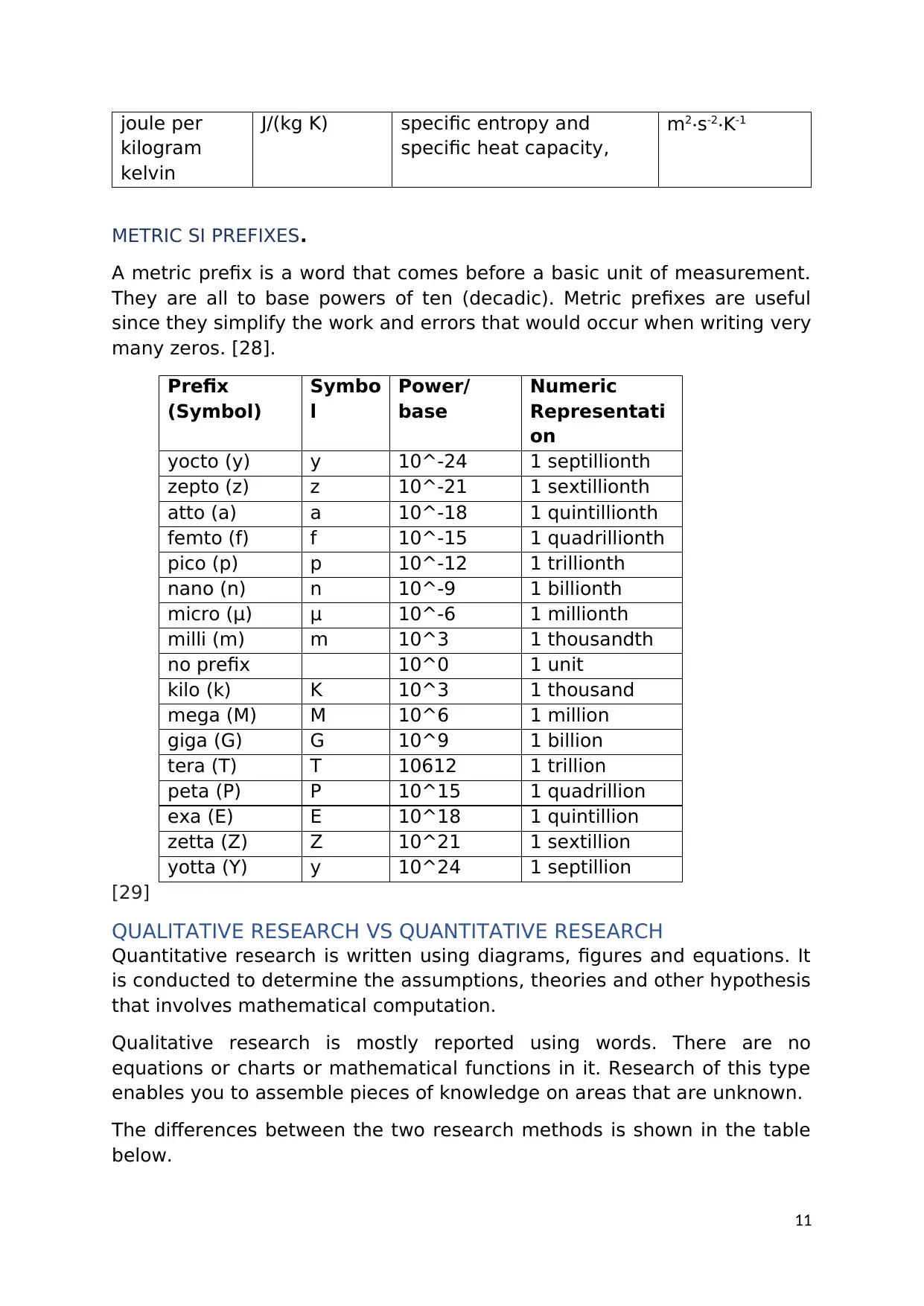
joule per
kilogram
kelvin
J/(kg K) specific entropy and
specific heat capacity,
m2⋅s-2⋅K-1
METRIC SI PREFIXES.
A metric prefix is a word that comes before a basic unit of measurement.
They are all to base powers of ten (decadic). Metric prefixes are useful
since they simplify the work and errors that would occur when writing very
many zeros. [28].
Prefix
(Symbol)
Symbo
l
Power/
base
Numeric
Representati
on
yocto (y) y 10^-24 1 septillionth
zepto (z) z 10^-21 1 sextillionth
atto (a) a 10^-18 1 quintillionth
femto (f) f 10^-15 1 quadrillionth
pico (p) p 10^-12 1 trillionth
nano (n) n 10^-9 1 billionth
micro (μ) μ 10^-6 1 millionth
milli (m) m 10^3 1 thousandth
no prefix 10^0 1 unit
kilo (k) K 10^3 1 thousand
mega (M) M 10^6 1 million
giga (G) G 10^9 1 billion
tera (T) T 10612 1 trillion
peta (P) P 10^15 1 quadrillion
exa (E) E 10^18 1 quintillion
zetta (Z) Z 10^21 1 sextillion
yotta (Y) y 10^24 1 septillion
[29]
QUALITATIVE RESEARCH VS QUANTITATIVE RESEARCH
Quantitative research is written using diagrams, figures and equations. It
is conducted to determine the assumptions, theories and other hypothesis
that involves mathematical computation.
Qualitative research is mostly reported using words. There are no
equations or charts or mathematical functions in it. Research of this type
enables you to assemble pieces of knowledge on areas that are unknown.
The differences between the two research methods is shown in the table
below.
11
kilogram
kelvin
J/(kg K) specific entropy and
specific heat capacity,
m2⋅s-2⋅K-1
METRIC SI PREFIXES.
A metric prefix is a word that comes before a basic unit of measurement.
They are all to base powers of ten (decadic). Metric prefixes are useful
since they simplify the work and errors that would occur when writing very
many zeros. [28].
Prefix
(Symbol)
Symbo
l
Power/
base
Numeric
Representati
on
yocto (y) y 10^-24 1 septillionth
zepto (z) z 10^-21 1 sextillionth
atto (a) a 10^-18 1 quintillionth
femto (f) f 10^-15 1 quadrillionth
pico (p) p 10^-12 1 trillionth
nano (n) n 10^-9 1 billionth
micro (μ) μ 10^-6 1 millionth
milli (m) m 10^3 1 thousandth
no prefix 10^0 1 unit
kilo (k) K 10^3 1 thousand
mega (M) M 10^6 1 million
giga (G) G 10^9 1 billion
tera (T) T 10612 1 trillion
peta (P) P 10^15 1 quadrillion
exa (E) E 10^18 1 quintillion
zetta (Z) Z 10^21 1 sextillion
yotta (Y) y 10^24 1 septillion
[29]
QUALITATIVE RESEARCH VS QUANTITATIVE RESEARCH
Quantitative research is written using diagrams, figures and equations. It
is conducted to determine the assumptions, theories and other hypothesis
that involves mathematical computation.
Qualitative research is mostly reported using words. There are no
equations or charts or mathematical functions in it. Research of this type
enables you to assemble pieces of knowledge on areas that are unknown.
The differences between the two research methods is shown in the table
below.
11

Quantitative research Qualitative research
These method emphasizes on
testing the hypothesis and
theories
The method focuses on exploring
ideas and methods by formulating
hypothesis and theories.
The research data is mainly in
the form of tables, graphs,
numbers, charts,
The research data is mainly
expressed in words
tatistical and mathematical
methods are used to analyze
the data collected.
The data is analyzed using non
mathematical methods such as
interpretation, classification and
summarizing.
The number of respondent
required is large.
The number of respondent required
must be small. Big number of the
respondent will give low quality
conclusions.
There are key terms that
governs these kind of research
such as replicability, objectivity,
measurement and testing.
The key terms that governs this
research are subjectivity,
complexity, context and
understanding.
Some of the research here have
closed questions (multiple
choices).
Open ended questions are usually
answered.
Apart from that there is also differences in the way the two methods
collect their data. Quantitative methods usually use context analysis:
recording the names and vocabularies of a particular topic, observation
the environment where the item under research is located or affecting.
Experiments, such as those done in the labs to determine properties that
can be hard to be determined using other methods and reviewing on the
literature done by others.
On the other hand, the methods of data collection usually associate with
the qualitative research are; literature reviews; the survey of previous
works by other researches. Case studies done by other researches. Focus
groups; specialized discussion about a certain field by people of great
knowledge to that field and interviews.
Two case studies for quantitative research and qualitative research.
Quantitative research case.
You are an engineer supervising the construction of a truck gearbox. In
order to approve the material which is bought from another manufacturer,
you decide to do fatigue and creep test for the material in order to
12
These method emphasizes on
testing the hypothesis and
theories
The method focuses on exploring
ideas and methods by formulating
hypothesis and theories.
The research data is mainly in
the form of tables, graphs,
numbers, charts,
The research data is mainly
expressed in words
tatistical and mathematical
methods are used to analyze
the data collected.
The data is analyzed using non
mathematical methods such as
interpretation, classification and
summarizing.
The number of respondent
required is large.
The number of respondent required
must be small. Big number of the
respondent will give low quality
conclusions.
There are key terms that
governs these kind of research
such as replicability, objectivity,
measurement and testing.
The key terms that governs this
research are subjectivity,
complexity, context and
understanding.
Some of the research here have
closed questions (multiple
choices).
Open ended questions are usually
answered.
Apart from that there is also differences in the way the two methods
collect their data. Quantitative methods usually use context analysis:
recording the names and vocabularies of a particular topic, observation
the environment where the item under research is located or affecting.
Experiments, such as those done in the labs to determine properties that
can be hard to be determined using other methods and reviewing on the
literature done by others.
On the other hand, the methods of data collection usually associate with
the qualitative research are; literature reviews; the survey of previous
works by other researches. Case studies done by other researches. Focus
groups; specialized discussion about a certain field by people of great
knowledge to that field and interviews.
Two case studies for quantitative research and qualitative research.
Quantitative research case.
You are an engineer supervising the construction of a truck gearbox. In
order to approve the material which is bought from another manufacturer,
you decide to do fatigue and creep test for the material in order to
12
⊘ This is a preview!⊘
Do you want full access?
Subscribe today to unlock all pages.

Trusted by 1+ million students worldwide
1 out of 16
Your All-in-One AI-Powered Toolkit for Academic Success.
+13062052269
info@desklib.com
Available 24*7 on WhatsApp / Email
![[object Object]](/_next/static/media/star-bottom.7253800d.svg)
Unlock your academic potential
Copyright © 2020–2025 A2Z Services. All Rights Reserved. Developed and managed by ZUCOL.

